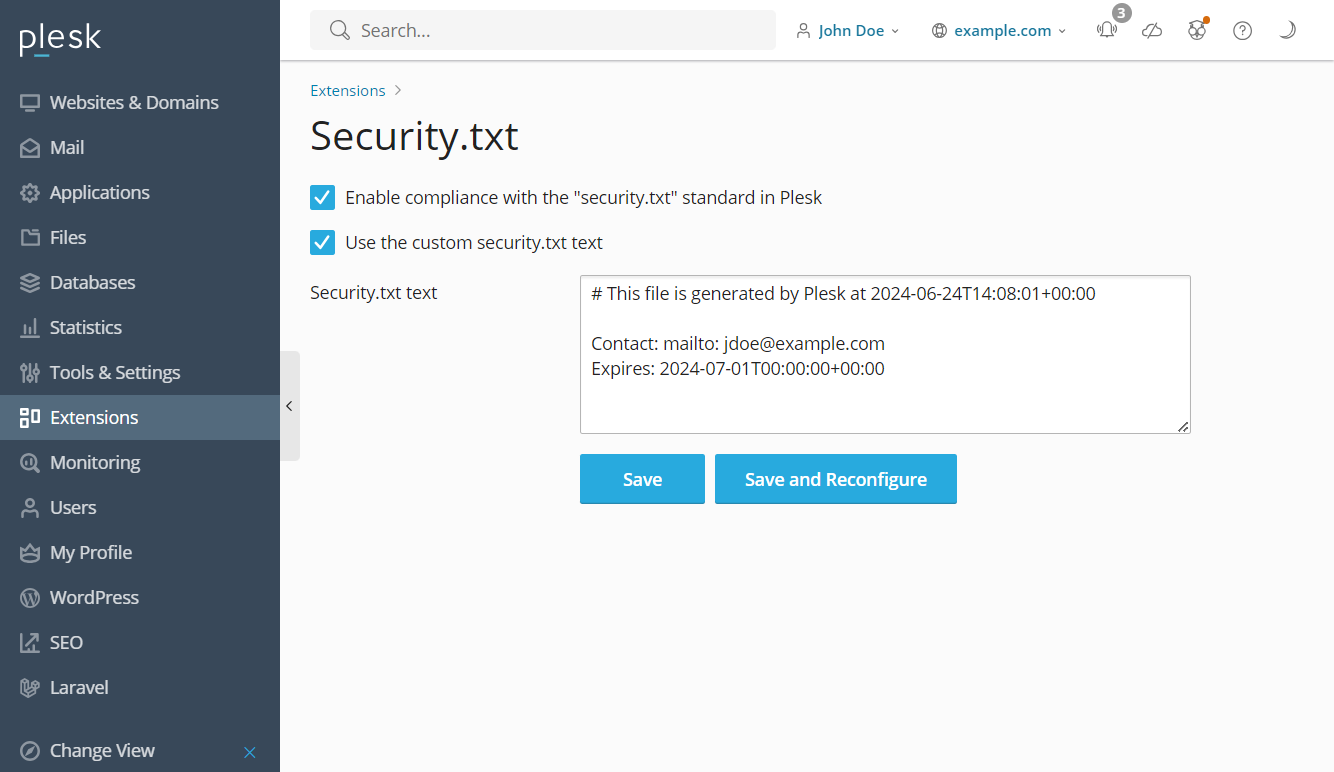Conformité à la norme Security.txt
security.txt est une norme largement répandue pour signaler les vulnérabilités de sécurité aux propriétaires de services. L’objectif principal de la norme security.txt est d’aider vos clients et les chercheurs en sécurité à vous contacter facilement lorsqu’ils trouvent une vulnérabilité dans un domaine Plesk.
À partir de la version 18.0.62, Plesk Obsidian est entièrement compatible avec la norme :
- Le fichier
security.txtest généré pour tous les domaines hébergés sur un serveur Plesk. - Plesk maintiendra en permanence le fichier
security.txtune fois qu’il sera créé et que la fonctionnalité sera activée. - Plesk prend en compte le fichier personnalisé
security.txtd’un domaine et n’applique jamais les politiques de sécurité du fichier du serveur au domaine. - Plesk met automatiquement à jour la date d’expiration du fichier.
Pour rendre votre serveur Plesk conforme à la norme security.txt :
-
Une fois l’extension installée, cliquez sur Ouvrir.
-
Cochez la case « Enable compliance with the « security.txt » (« Activer la conformité avec la norme « security.txt » dans Plesk »).
-
(Facultatif) Pour modifier le fichier
security.txtpar défaut généré par Plesk, cochez la case « Use the custom security.txt text » (Utiliser le texte security.txt personnalisé) ». Spécifiez ensuite ce qui doit être modifié dans le champ « Security.txt text » (Texte security.txt) qui devient disponible. Vous pouvez également modifier le fichier depuis l’interface en ligne de commande. -
Enregistrez vos modifications en cliquant sur :
-
Save (Enregistrer) pour enregistrer la configuration et appliquer les modifications manuellement par la suite. Par exemple, vous pouvez le faire pour accorder plus de temps à vos clients. Ils pourront ainsi reconfigurer leurs domaines conformément aux modifications et éviter d’éventuels problèmes. Vous pouvez reconfigurer le serveur manuellement en exécutant la commande CLI
plesk repair web. - Save and Reconfigure (Enregistrer et reconfigurer) si vous souhaitez appliquer les modifications et reconfigurer le serveur Plesk dès maintenant.
Votre serveur Plesk est désormais conforme à la norme security.txt.
Utilisation de l’utilitaire de ligne de commande
Vous pouvez utiliser l’utilitaire de ligne de commande plesk ext security-txt-plesk pour mettre à jour votre configuration security.txt. Cet utilitaire accepte les commandes suivantes :
-
--help` : imprime toutes les commandes ``security-txt-pleskdisponibles. -
--status: indique si le serveur Plesk utilise les politiquessecurity.txt. Si vous avez activé la politiquesecurity.txtpar défaut, la valeurvalue: onsera renvoyée. Si vous avez activé une politiquesecurity.txtpersonnalisée ou utilisé un chemin de fichier personnalisé, la valeurvalue: customsera renvoyée. -
–enable : cette option permet à tous les domaines de votre serveur Plesk d’utiliser les politiques
security.txtpar défaut. Elle désactive les chemins de fichiers personnalisés et l’option « Use the custom security.txt text » (Utiliser le texte security.txt personnalisé) » dans le menu des extensions. -
--disable: définit tous les domaines de votre serveur Plesk pour ignorer toutes les politiquessecurity.txt. -
-
-path: définit un nouveau chemin d’accès pour le fichiersecurity.txt. Pour définir un nouveau chemin d’accès pour un fichiersecurity.txt, vous devez d’abord avoir un fichiersecurity.txtà cet emplacement. -
Note:
Pour que cette commande fonctionne, vous devez d’abord activer l’option « Use the custom security.txt text » (Utiliser le texte security.txt personnalisé) » dans le menu de l’extension Native security.txt compliance » (Conformité native security.txt)». Ensuite, vous devez inclure la commande
--reconfigure-all. Par exemple, pour utiliser un répertoiresecuritypersonnalisé pour votre fichiersecurity.txt, créez le nouveau fichier et le nouveau répertoire. Ensuite, exécutez la commande suivante :plesk ext security-txt-plesk -path /security/security.txt --reconfigure-all.
-
-
--reconfigure-all: met à jour tous les domaines sur le serveur Plesk pour utiliser la nouvelle configurationsecurity.txt.
